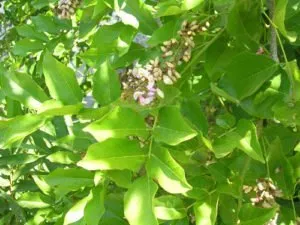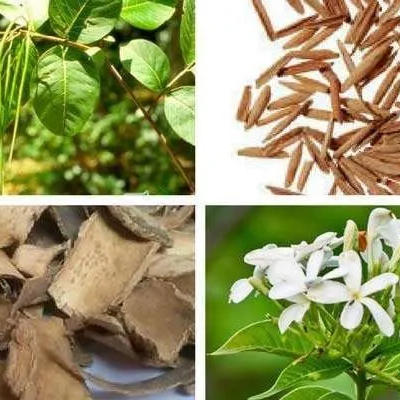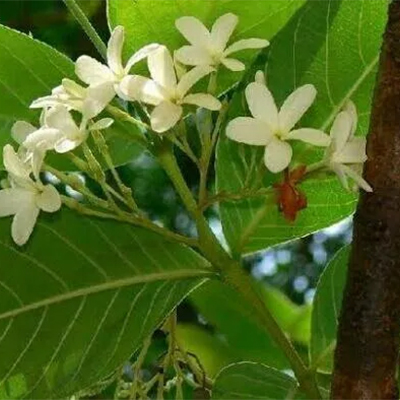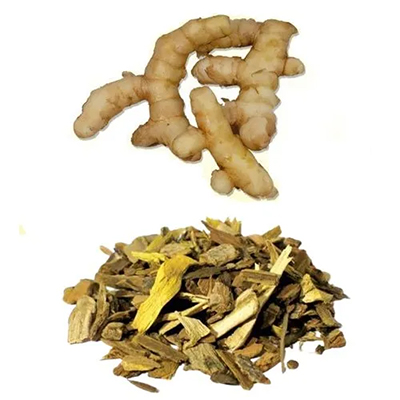On This Page
Karanja – Pongamia glabra
Karanja commonly known as Indian beech is one of the many plants with diverse medicinal properties, where all its parts have been used as traditional medicine in the treatment and prevention of several kinds of ailments in many countries such as for treatment of piles, skin diseases, and wounds. Ayurveda as well modern medical science is using its benefits of useful phytochemical source and potency in healing a number of ailments including skin allergies. This plant is having proven immunomodulation, anti-viral and anti-allergic actions.
Single herb extract therapy with Karanja, is one among the unique method performed by Dr.Gupta in healing various skin diseases with difficult prognosis. Allergic conditions are showing high success rates in the cure with the help of Indian beech plant or Karanja.
Several different classes of flavonoid derivatives, such as flavans, flavones and chalcones and several types of compounds including terpenes, steroid and fatty acids have been isolated from different parts of this plant. The pharmacological and Ayurveda studies revealed that various types of preparations, extracts and single compounds of this species exhibited a broad spectrum of biological activities such as antioxidant, antiallergic, antimicrobial, anti-inflammatory, and anti-diabetic activities.
Importance of Karanja in Skin Allergy
Stem and bark of pongamiapinnata, a medicinal tree of importance in Ayurveda has been subjected to various pharmacological studies using the aqueous extract in different dose levels. The aqueous extract of bark exhibited significant anti-allergic and antipyretic effects in the various researches conducted by our research team. The presence of unique constituents namely karanjin, ponapin, kanjone, pongaglabrone and pongamol are responsible for the anti-allergic and immunomodulation action. The presence of oil capable healing wide range of skin condition gave the name “Bio-diesel” to Karanja. The unique bloodletting therapy performed with Karanja is highly beneficial in healing various skin ailments. Along with magical anti-allergic action, Karanja also possess anti-bacterial and anti-inflammatory actions.
Vernacular Names and Botanical Classification
| Vernacular Names | |
| Hindi name | Dithouri |
| Sanskrit name | Karanja |
| English name | Indian beech |
| Malayalam, Tamil name | Pongum |
| Kannada name | Honge mara |
Botanical name
Pongamia glabra
Family
Fabaceae
Phytomorphology of Karanja Pongamia glabra
- Pongamia glabra is commonly known as “Indian beech” is a medium sized tree that grows upto 40 ft in height. It grows through out India.The leaves are compound type having arranged alternately with 5-7 leaflets in it.The leaves have elliptical shape. The flowers of Pongamia glabra are papilionaceous and seen in fascicles of 2 to 4 on the rachis. Standard petal is suborbicular either curved folds above the claw.
- The most used part of the tree is the seeds which are single in fruitand reniform shaped. The fruits are pod in nature and shaped obliquely oblong.
Ayurvedic Reference of Karanja

Habitat of karanja – Pongamia Glabra
Karanja plant grows through out India especially in the banks of rivers, lakes, and both the sides of streams. It is very common in south India.
Phytoconstituents of Karanja – Pongamia glabra
Different classes of organic compounds with various medicinal uses have been found in Pongamia glabra. The stem contains Karanjin and Pongapin. Seeds contain Glabrin, Karanjin, Pongapin, Kanjone, Pongaglabrone and Pongamol chemical constituents rich dark color oil popularly known as Pongamia oil.
Parts Used of Karanja Pongamia glabra
Karanja seed extract, stem, leaves and root bark are used as an internal medication for oral intake generally for its antiviral property. Its paste is also applied in various skin ailments. Seed oil is marketed as karanja oil widely.
- Seed
- Fruits
- Leaves
- twigs
- Stem
- Root bark
Preparation and dosage of Karanja
- Powder (choornam) – 1-3 gm per day
- Juices (swaras)–10-20 ml two times a day
- Kashyam– 12.5ml two times a day
- Oils (taila) – 3 ml per day (external)
- Ointment– In piles externally
Medicinal Properties and Uses of Karanja
- Vata kaphasamak – recommends in disorders imbalanced by vata and kapha doshas. Due to itsushnavirya it decreases vata and due to katuvipaka it decreases kapha.
- Kandughna- used in the symptom of skin itching
- Kushtaghna-useful in skin diseases like eczema, lichen and psoriasis
- Shothnivaarana: Relieves Inflammation
- Vrana ropaka- used for fast recovery of wounds and ulcers
- Vedanasthapana- used for relieving pain
- Deepana- for relieving poor digestic capacity
- Pachana- increases digestive action
- Arshahara: relief in piles
- Krumighan: helps to kill intestinal worms
- Pittavardhak: Increase pitta doshas

Have A Health Issue?
Consult Online
- Dr. Sahil Gupta (B.A.M.S., M.H.A.)
Ayurvedic Allergy Specialist
CEO & Founder of IAFA®
Home remedies of Karanja Pongamia glabra
Karanja or Indian beech tree is used from ancient times especially in Indian sub-continent. Our ancient sages lived in the parts of Himalayas even used this drug in emergency management of sports injuries.
- Allergic condition of skin- the decoction made from the fresh bark of Karanja is useful in curing skin related allergies. This decoction taken once daily will cure skin allergic conditions.
- Eczema- the paste made of turmeric and Karanja seeds relives various symptoms of eczema.
- Herpes- hot paste prepared from Pongamiaglabra bark is applied in herpes.
- Ano-rectal diseases- like piles, fistula and fissure- The decoction made from the leaves helps in curing all the above mentioned ano-rectal conditions.
- Digestive system disorders- like diarrhea and intestinal burning sensation- Root bark decoction of Karanja is used in the treatment of digestive system disorders like diarrhea and burning sensation.
- Sciatica and Lower back pain- The leaves are cut into small pieces, cooked well and packed in small cloth bags for performing massages of the nerve roots in case of sciatica. Sesame oil and salt can be added for getting best results.
- Non-healing ulcers- Root bark is smoked and the smoke is exposed to the wound for attaining fast healing in case of non-healing ulcers.
- Dental and oral cavity care- Karanja twigs are used for brushing. The anti-bacterial activity of karanja helps in preventing tooth decaying.
- Joint disorders- Karanja oil is used in the management of joint disorders with inflammatory changes.
Dr.Gupta’s IAFA has been conducting research programmes to identity the phytoconstituents and actions of various drugs used in Ayurveda. Our system mainly aims in the growth of Ayurveda science and maintains a strict protocol to ensure the safety of all consumers. The well experienced members of IAFA are consistently working to find out the most effective ways to cure all diseases especially Allergic disorders. All the herbs used in our system are mentioned in the basic texts of Ayurveda and are collected naturally.
Reach IAFA for safe herbal remedies for all your ailments!!!










